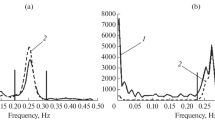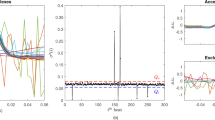Abstract
Although respiratory sinus arrhythmia (RSA) is a well-known and often studied phenomenon, methods to estimate (average) respiratory rate from heart rate variability via RSA have been investigated and published only sparsely. We reinvestigate three published techniques and contrast them to our own approaches. All methods were also evaluated for respiration signals to yield approximations of the true breathing rate for comparison. Our analyses are based on physiological recordings available at PhysioNet, an online database. Results show that the RSA of young supine subjects yields good approximations of mean respiratory rate in the case of time series longer than 1 min, while the estimations become noticeably less accurate for elderly persons. Our own “advanced counting method” produced the best results, and in addition principally permits even the definition of instantaneous respiratory rates. Consequently, it is recommended for further investigations.






Similar content being viewed by others
Notes
We optimized these factors empirically by testing values at intervals of 0.02. The threshold for HRV data is comparatively small, because (a) oscillations of RSA are not always as distinct as those of respiration itself and (b) “false” maxima or minima seem to occur less prominently in RSA.
References
Bailón R., Sornmo L., Laguna P. (2006) A robust method for ECG-based estimation of the respiratory frequency during stress testing. IEEE Transact. Biomed. Eng. 53:1273–1285
Bettermann H., Engelke P., van Leeuwen P., Heckmann C. (1996) Determination of respiratory rate on the basis of respiratory sinus arrhythmia (in German). Biomed. Tech. 41:319–323
Denver J. W., Reed S. F., Porges S. W. (2007) Methodological issues in the quantification of respiratory sinus arrhythmia. Biol. Psychol. 74:286–294
Frühwirth, M. Methods for calculation of respiration rate and respiratory sinus arrhythmia from heart rate variability (in German). Master’s thesis, Technical University of Graz, Austria, 2003
Goldberger, A. L. L., A. N. Amaral, L. Glass, J. M. Hausdorff, P. C. Ivanov, R. G. Mark, J. E. Mietus, G. B. Moody, C.-K. Peng, and H. E. Stanley. PhysioBank, PhysioToolkit, and PhysioNet: Components of a new research resource for complex physiologic signals. Circulation 101(23):e215–e220, 2000. Circulation Electronic Pages: http://www.circ.ahajournals.org/cgi/content/full/101/23/e215
Heckmann C., Schenk D. (1985) Klinisch-rhythmologische Aspekte der Momentanherzfrequenz-Analyse aus dem 24-h-EKG. Herzmedizin 8:134–145
Iyengar N., Peng C.-K., Morin R., Goldberger A. L., Lipsitz L. A. (1996) Age-related alterations in the fractal scaling of cardiac interbeat interval dynamics. Am. J. Physiol. 271:1078–1084
Lin L. I.-K. (1989) A concordance correlation coefficient to evaluate reproducibility. Biometrics 45:255–268
Mason, L. Signal processing methods for non-invasive respiration monitoring. PhD thesis, University of Oxford, UK, 2002. Available online at http://www.eng.ox.ac.uk/bsp/laura_thesis.pdf
Mason, C. L., and L. Tarassenko. Quantitative assessment of respiratory derivation algorithms. In: Proceedings of 23rd Annual International Conference of the IEEE Engineering in Medicine and Biology Society, Istanbul, October 2001, pp. 1998–2001
Moody G. B., Mark R. G., Zoccola A., Mantero S. (1985) Derivation of respiratory signals from multi-lead ECGs. Comput. Cardiol. 12:113–116
Schäfer, A. The effect of light of various spectral composition on heart-rate variability (in German). PhD thesis, University of Vienna, Austria, 2004
Task Force of The European Society of Cardiology and The North American Society of Pacing and Electrocardiology. Heart rate variability standards of measurement, physiological interpretation, and clinical use. Eur. Heart J. 17:354–381, 1996
Yasuma F., Hayano J. (2004) Respiratory sinus arrhythmia: why does the heartbeat synchronize with respiratory rhythm? Chest 125:683–690
Zetterberg L. H. (1969) Estimation of parameter for linear difference equation with application to EEG analysis. Math. Biosci. 5:227–275
Acknowledgments
We would like to express our gratitude to PhysioNet and Iyengar et al.7 for making physiological data available to other researchers for further investigation. We consider PhysioNet a remarkable project deserving our appreciation.
Author information
Authors and Affiliations
Corresponding author
Rights and permissions
About this article
Cite this article
Schäfer, A., Kratky, K.W. Estimation of Breathing Rate from Respiratory Sinus Arrhythmia: Comparison of Various Methods. Ann Biomed Eng 36, 476–485 (2008). https://doi.org/10.1007/s10439-007-9428-1
Received:
Accepted:
Published:
Issue Date:
DOI: https://doi.org/10.1007/s10439-007-9428-1




